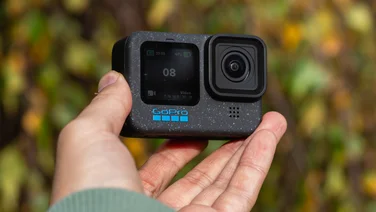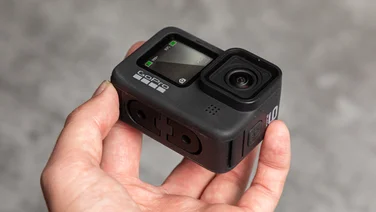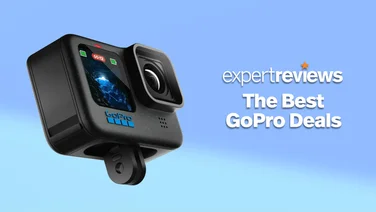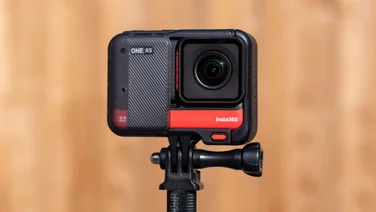To help us provide you with free impartial advice, we may earn a commission if you buy through links on our site. Learn more















- Fold-out prongs mean you don't need a cage to mount it
- Better video stabilisation
- New timelapse features are great
- Won't fit older GoPro cases
- A little pricey
GoPro has been in the action camera game so long now that it wouldn’t make much sense to introduce dramatic changes too often. Devotees of the brand and professional users will already own a bank of accessories and mounts. They’ll be used to the GoPro’s menus and settings, too.
But while the Hero 8 Black keeps things familiar for GoPro devotees – it’s a similar shape and size as the year-old Hero 7 Black and has a similar menu system – it does its best to shake things up within those restraints.
READ NEXT: GoPro Hero 9 Black review – the best action camera yet
GoPro Hero 8 Black review: What you need to know
In fact, the list of improvements in terms of hardware and software is surprisingly extensive. And while it looks familiar, there are GoPro has made some subtle but significant changes, with a slightly larger body, a lens housing that sticks out less and fold-out mounting prongs, so you can mount it to accessories without needing a separate frame.
GoPro has added a new microphone, made its electronic image stabilisation even better, added new time-lapse features, upped the maximum video bit rate and it has upgraded the battery as well.















It’s also made the camera easier to use with the addition of camera presets. Not only that, but later this year, a series of Mods will arrive that to allow those seeking a super-compact vlogging kit to add LED lights and higher quality external mics.
Otherwise, the GoPro Hero 8 Black has most of the features that made the Hero 7 Black so good. Its water-, shock- and dust-resistant without the need for a case, shoots 4K footage at up to 60fps and can be controlled remotely via the GoPro app or via voice command.
GoPro Hero 8 Black review: Price and competition
The GoPro Hero 8 costs £380 – the same as the Hero 7 Black last year – and at that price there isn’t a huge number of alternatives to choose from. You have the DJI Osmo Action, which is a similar size and shape and comparable in terms of features, but costs significantly less at £280.
Sony’s FDR-3000XR is a tad more costly but is more bulky and has a separate, physical viewfinder screen, instead of one built into the body of the camera and needs to be popped into a waterproof housing to make it water-resistant. Then you have the GoPro Hero 7 Black, which you can now buy for around £280 since the launch of the Hero 8 Black. It’s still a great action camera and a bargain at that price.
Finally, for vloggers, there’s also the DJI Osmo Pocket, which combines action camera features with a built-in mechanical gimbal for super-smooth stabilisation. It’s a good deal less rugged than the GoPro cameras, though.
GoPro Hero 8 Black review: Design
Despite its slight redesign, the Hero 8 Black is still unmistakably a GoPro with its square lens housing and compact, blocky body, and like the Hero 7 Black, it’s waterproof down to 10m without needing to be popped into a case.
Unlike the Hero 7 Black, however, the Hero 8 Black doesn’t need to be snapped into a plastic frame before being attached to a mount. That’s because it has a pair of fold-out mounting fingers embedded in its base. Flip them out, slot them into your helmet, chest- or tripod mount and you’re pretty much ready to go.
This does mean the camera is a tiny bit bigger than the Hero 7 Black – a few millimetres taller and wider – but it’s a good deal more compact than a Hero 7 in its mounting frame. And there’s another big upside, too: you can now remove the battery without having to unclip the camera and pull it out of its frame. It’s a far more elegant design, so much so that you have to wonder why GoPro hasn’t done this before.















GoPro has made some other, less dramatic tweaks to the design too. The lens housing now protrudes less from the front, in order to reduce wind turbulence while you’re moving and that lens housing’s Gorilla Glass protection is now more shock resistant. There’s also now only one flap to worry about securing – found on the right edge of the camera, this covers the microSD card slot, the battery and the USB Type-C charging and data port.
There are a couple of negatives here, though. The Hero 8 Black no longer has a Micro HDMI output; you have to purchase the forthcoming Media Mod to get that back. And the new shorter lens housing means any filters you may have purchased for previous models now won’t fit. The same goes for any cases you may have purchased previously. Due to the Hero 8 Black’s slightly more portly shape, it’s highly likely they’ll simply not fit.
Elsewhere the power button has been moved from the right to the left side of the camera, which might also cause some initial confusion. However, the rest of the GoPro’s physical features remain familiar. The touchscreen on the rear is identical, as is the monochrome status LCD on the front, which is a shame since the DJI Osmo Action’s front screen is full colour and can be used to frame self-portrait shots.















GoPro Hero 8 Black review: New features
That’s plenty enough to be getting on with but GoPro hasn’t just settled on improving the physical design. There’s also an extensive list of improvements to the camera’s various video and photo recording capabilities. First up, an improvement to the GoPro’s electronic stabilisation, which was already impressive in the Hero 7 Black.
Now called Hypersmooth 2.0, this is not only capable of smoothing out footage more effectively than before, but it can also now be applied to all recording modes, including 4K at 60fps or 50fps.
In normal and “High” modes the difference between HyperSmooth 2 and 1 isn’t that great. With the Hero 8 and 7 Black cameras mounted next to each other on a plank of wood, I set off down my street at a brisk walk and when I put the resulting videos side-by-side, the Hero 8’s footage looked only slightly smoother.
It’s only when you hit the Boost button that you see a big difference, with footage taking on an uncanny, gimbal-like motion that’s noticeably smoother than on the Hero 7. It’s even possible to lock the horizon in this mode, although you can only enable this feature from the app. The other issue with Boost is that there is some small loss in quality when you engage it – footage takes on a slightly more compressed, unnaturally contrasty appearance – and, unlike HyperSmooth 2, Boost it isn’t available at the highest 50 or 60fps frame rates.
Next up, TimeWarp 2, which also receives a handful of new features. TimeWarp is GoPro’s video time-lapse feature, which instead of capturing lots of stills and then smooshing them together to produce a speeded-up video, captures video and shrinks that down to achieve a similar result. The quality isn’t as high but TimeWarp has the advantage of being stabilised, so it’s good for shooting time-lapses when you’re walking, running or biking.
The new TimeWarp feature is Auto, which takes the guesswork out of which speed to set it at, basing settings on your motion and the scene you’re capturing. This worked fantastically well when I tested it, producing perfect time lapses of everything from a stroll around a town centre to a hectic, downhill mountain bike run. The option is still there to manually select how fast or you want your time lapse to be, of course, and with experience, you’ll know what speed to set it at but it’s much easier to simply stick it in Auto.
The next handy feature is the ability to tap the screen and drop smoothly into real-time video midway through a time-lapse video and to tap it again to ramp back into regular time-lapse mode. This is something you’d have to do in post previously, so it’s great to be able to do it on the fly now.
Those are the camera’s major new features but there are plenty of other, smaller improvements, too. There’s a new NightLapse photo mode, which you can use for capturing longer night-time time lapses including things like lightning storms, sunrises and sunsets. LiveBurst mode captures a pre- and post-capture three-second burst of stills at either 8 or 12 megapixels, letting you either share that burst as a short video clip or select the best frame from it. It’s a feature that could help you capture a moment you might otherwise have missed with another camera, simply because you hit the shutter button too late or, perhaps, to early. There’s also a new 1080p live-streaming mode to Facebook and YouTube if you just can’t wait to get your footage online.
One of my favourite new features, however, has to be the new presets facility, which lets you set up to ten user capture modes and name them for quick recall. When you’re out on a shoot or the trail and you’d rather not be memorising settings and scrolling through multiple screens to get to the options you need, this is an absolute godsend. For those who want to get into it, it’s also possible to customise certain onscreen controls as well.















GoPro Hero 8 Black review: App and UI
As well as plenty of new on-camera features, the app has been given an upgrade and the biggest one is that GoPro has now integrated its Quik semi-automatic editing software right into the main app. Previously, the apps were separate, which didn’t make an awful lot of sense.
All you need to do now to create a quick auto edit is select your clips, hit the clapperboard icon at the bottom of the page and the app will do the rest, adding cuts, music and titles all automatically, based on moments it identifies in each clip. This is great for a quick edit when you can’t be bothered to get stuck into the details, but there’s plenty you can do to tweak it if you want to.
It’s possible to tap to select highlights, to ensure those are included in the edit. It’s also possible to adjust the length of the overall project, tweak the trimming of individual clips, rotate the video, add horizon levelling, creative filters (with 20 new ones to choose from) and adjust the speed of the clip. You can, of course, also change the overall theme of the presentation, too, and GoPro has expanded the selection. It’s a pretty flexible tool overall, and good to see GoPro going for the one-app experience.

As before, the app can still be used to remote control the camera and preview video framing. I found some odd inconsistencies here between the settings on the camera and the app, particularly surrounding the HyperSmooth settings, but those will likely be ironed out in time. In general, though, I’ve found the app, and the connection between camera and phone to be a lot more reliable than on the Hero 7 Black I tried a year ago.
The same goes for the UI on the camera itself. Having used the camera for around a week on and off, I’ve had it freeze on me only once. And, despite the fact that GoPro hasn’t changed the image processor at all, it feels a tiny bit more responsive. The sheer number of modes and settings, however, remains baffling and wrapping your head around it all will take some time if you haven’t owned a GoPro before.
GoPro Hero 8 Black review: Image and audio quality
With the same 12-megapixel sensor, lens and S1 image processing chip, it won’t surprise you to find that the overall image quality on offer isn’t all that different from before. As such, the recording resolutions are the same, too.
The camera can record 16:9 video at 4K, 2.7K, 1440p, 1080p, and 720p resolutions, mostly at 60fps; only the widest SuperView field of view restricts you to 30fps. Slow-motion clips can be shot at 2.7K at 120fps, and 240fps at 1080p or 720p.
And you can capture at bit rates of up to 100Mbits/sec in 4K and 2.7K modes, too, which is the highest bitrate GoPro has ever deployed on its action cameras. That’s equivalent to 200Mbits/sec in MP4 and a 22Mbits/sec improvement over the Hero 7 Black’s 78Mbits/sec. Regular, or “Low” bitrate videos are recorded at 60Mbits/sec in 4K and 2.7K. And the quality of video is excellent with consistently well-judged exposures, solid colour reproduction and a good level of detail across all modes.
Those aren’t the only improvements, though. GoPro has also added a narrow-field-of-view option to the existing extra-wide SuperView, Wide and Linear options for both video and stills. There’s also improved HDR for the camera’s SuperPhoto mode, although if you ask me if you’re using a GoPro for stills you need your head read.















Audio quality is great, too, with the Hero 8 Black’s new lens housing design working remarkably well to cut wind noise when you’re on the move. You have four audio modes to choose from – wind reduction on, off, auto and RAW – but whichever you select, audio quality is excellent.
With the microphone positioned on a rucksack strap, I found voice pickup would become a touch muffled as I picked up speed but the wind reduction was remarkably effective. Even at around 25mph it was able to reduce wind roar almost completely and picked up my voice surprisingly clearly.
GoPro Hero 8 Black review: Verdict
The GoPro Hero 8 Black doesn’t represent a massive jump forward in image quality over the Hero 7 Black, then, but GoPro hasn’t rested on its laurels. The new built-in mounting prongs are a big improvement over the clunky clip-on frame of previous generations and it’s good to see GoPro giving its stabilisation system a boost. The new auto TimeWarp mode is simply brilliant and the microphones are very impressive at reducing noise from wind turbulence on the move.
In truth, none of these improvements is particularly groundbreaking and none push the category forward in a huge way, either. But there are enough changes here that, when added together, represent a significant upgrade. It may be more expensive than its rivals but Hero 8 Black replaces the Hero 7 Black as the new king of action cameras.








